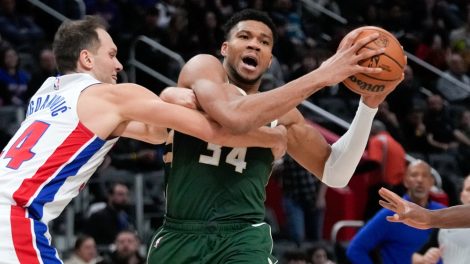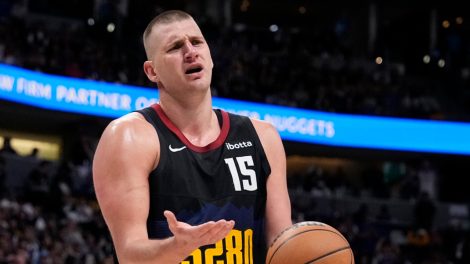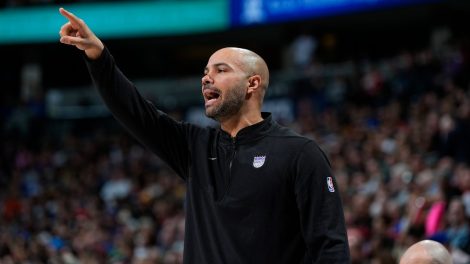With the Indiana Pacers on an 8-2 run and the Raptors trailing for just the second time in a pivotal, season-defining Game 7, Norman Powell received a pass from Kyle Lowry in the left corner. As Paul George closed out, Powell confidently put the ball on the floor, found Cory Joseph with a pass, and faded to the opposite corner.
The shot clock down to five, Powell had little choice but to let fly when Joseph sent it back his way, and he did so confidently. It wasn’t the first big shot he’d hit in the series, but in those 10 seconds, his breakout rookie season and the growth that made it possible were distilled into a single highlight.
Less than a minute later, Joseph found Powell in the corner in transition, and he found the bottom of the basket to push the newfound lead to four. The human timeout generator had forced Frank Vogel’s hand once again. He’d hit another three in the fourth quarter, this one more scripted than the others but no less important.
Powell had a number of incredible moments in the Raptors’ first-round victory over the Pacers – the game-tying dunk during the epic Game 5 comeback, multiple on-ball steals and jumped passing lanes, tough defensive possessions opposite Paul George – but none mean more to Powell’s long-term outlook as the six threes he hit.
Shooting was supposed to be a weakness for Powell coming out of UCLA as a senior. Over four seasons, Powell canned 111 triples but shot just 31.4 percent, and while his mid-range stroke suggested he may ultimately improve, a perceived lack of range and a misplaced concern about his height were the biggest limiting factors to his draft stock.
The Raptors liked enough of what they saw in his pre-draft workouts and interviews. They also weren’t as concerned about his shooting numbers as most, seeing a slight mechanical flaw they believed they could iron out. “I think there’s a bit of a misnomer that he had a broken shot,” says assistant coach Jama Mahlalela, who, along with Jerry Stackhouse, is often tasked with overtime hours so Powell can get additional reps in. “It was a decent shot to start with. I think what we’ve done is just tweak it and provide him the repetitions at that tweaked positioning to allow him to be successful.”
The issue, Powell says, is that he rose just as high on his set catch-and-shoot threes as he did on his pull-up mid-range shots. That kind of lift is necessary to get an off-dribble shot off against a tight defender or in traffic, but as a stationary weapon, it was superfluous effort and movement. He already releases high thanks to his 6-foot-11-plus wingspan, and the height of his motion allowed a larger window for inconsistencies, like occasionally releasing the ball as he began his descent.
From the moment he was drafted, Powell got to work on retooling his stroke. He worked on it through summer workouts with DeMar DeRozan, who came away impressed with the rookie, before Powell moved on to work with Raptors staffers, including his eventual D-League coach Jesse Mermuys, who headed up the organization’s team for Las Vegas Summer League (he was 4-of-9 in that tournament).
His assignments to Raptors 905 during the season focused primarily on distributing when attacking off the catch, and Powell continued to shoot rack after rack to ensure opponents would close out on him hard enough to make that new skill valuable (he was 8-of-24 as a D-Leaguer). “There are a ton of grinders in the NBA,” says Mermuys, before listing Powell among a who’s who of notorious gym rats. “One thing that seems to separate him is the work doesn’t seem to fatigue him as much as others, and his mental approach seems a little more focused. Most really want it but are not as mature in the outlook or approach.”
“Most NBA rookies put the same amount of time in, for the most part,” Mahlalela adds, moments after having to quite literally kick Powell off the floor the day before a playoff game. “The difference with him is how he spends that time. Not once this entire season have I said, ‘Hey, Norm, let’s work harder.’ It’s, ‘Hey, let’s slow down a little bit.’ The way he spends his time is what differentiates him.”
But changing a shooting motion isn’t as easy as just working hard. If it were, Powell would be Steph Curry. By the time he was drafted, Powell had used the same shooting motion so long that muscle memory was tough to break. That meant shooting session after shooting session, with a staffer on hand to watch his form, making sure he wasn’t jumping as high, that his motion was compact, and then to correct him when fatigue or instinct set in and he resorted to his old form.
That’s something that happened less and less as time went on, but took an unfathomable amount of shots to eliminate completely.
“Shoot. Wow,” Powell says of the long process. “I’ve probably put up 100,000 shots already. Probably in a span of a month and a half, I put up 100,000 shots, it seems like.”
Around midseason, Mahlalela had to begin increasing the difficulty of Powell’s shooting workouts. Yet as Powell began getting semi-regular run, it seemed he had left his shot behind in the practice gym. But the coaching staff was undeterred.
“I think it was soon after the All-Star break,” Powell recalls. “Jama was telling me in those games, ‘You’re three games away, you’re two games away, you’re one game away’ from it falling in a game.”
On March 15, Powell took over as the team’s starting shooting guard for the remainder of the season. After shooting 18.2 percent on threes over his first 32 games, Powell caught fire, raining napalm from long-range and turning his scouting report to ash – over the final 17 games, he knocked down 47.8 percent of nearly four attempts per-game. Even still, it wasn’t until the final stretch that he gained complete confidence.
“It was in that last five or six games when we got to give him more minutes that I think, for me, I was saying, ‘That ball’s going in,’” says Mahlalela, “because you could see the pureness of his shot. And he could feel it as well when he released it.”
Powell finished the season 36-of-89, a 40.4-percent clip, and while 89 3-point attempts is hardly significant given an estimated stabilization point of 750, Mahlalela believes Powell’s earned the right to add 3-point shooting to his role card for 2016-17.
“He’s shot enough during the season, for sure, at a successful amount,” says Mahlalela, “for me to call him a 3-point shooter.”
Powell opened the playoffs 3-of-15 from outside before calling on Mahlalela to once again lend a hand to iron things out. The results swung a Game 7, and because everything – accomplishment or failure, compliment or criticism – “motivates my grind,” those clutch threes will provide even more fuel for Powell’s unrelenting workouts.
“I’ve always had confidence in my shot. But right now, I’m really confident in it,” Powell says, pointing out that the Pacers began trying to run him off the line more as the series wore on, opening up driving opportunities. “If I can continue to shoot the ball well, it just opens up my whole game.”









